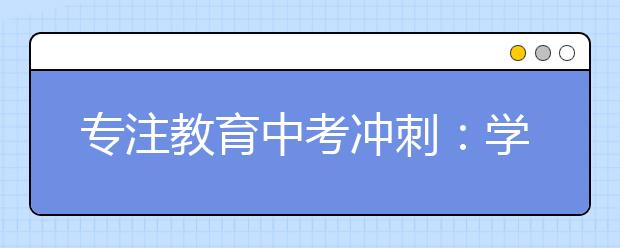
英语考试中一个很重要的考点就是各种英语句型,今天专注教育老师为大家介绍的这30个英语句型包含了所有中考高频考点,赶紧收藏!
1. keep sb. doing sth. 让某人一直做某事
不可和keep sb.from doing sth.结构混淆。
例如:Why do you keep me waiting for a long time? 你为什么让我等了很长时间?
2. make sb. do sth. 使某人干某事
make意为“使”时,其后要有不带to的动词不定式。
例如:He made me work ten hours a day. 他让我每天工作10小时。
注意:上句如改为被动语态,则work 前的to不能省略。例如:
I was made to work ten hours a day.
3. neither…nor…既不……也不……
当连接两个并列主语时,谓语动词与邻近的主语取得一致(就进一致原则)。例如:
Neither we nor Jack knows him. 我们和杰克都不认识他。
He neither knows nor cares what happened. 他对发生的事情不闻不问。
4. not…until…直到……才……
until后可跟名词或从句,表示时间。例如:
He didn’t come until late inthe evening.他直到晚上很迟才来。
He didn’t arrive until thegame began. 直到比赛开始他才来。
5. sb. pays money for sth. 某人花钱*某物
此句型主语是人。例如:
I’ve already paid2,000 yuan for the motor bike. 我已经花了2000元*这辆摩托车。
6. spend time/money on sth./(in)doing sth. 花费(时间、钱)在某事上/做某事
其中in可以省略,通常主语为“人”。例如:
I spent five yuan on this book. 我在这本书上花了五元钱。
I spent two hours (in) doing my homeworkyesterday. 昨晚我花了两个小时做作业。
7. so…that…太……以至于……
用于复合句,that引导的是结果状语从句。so是副词,后面应接形容词或副词,如果接名词,应用such。例如:
The ice is so thin that you can’t walk onit. 冰太薄了,你不能在上面走。
He is such a kind man that we all like him.他是一个非常好的人,我们都很喜欢他。
8. stop to do sth, stop doing sth.
stop to do sth. 意为“停下来去做另一件事”,stop doing sth.意为“停止正在做的事”例如:
You’re too tired. You’d betterstop to have a rest. 你们太累了,最好停下来休息一会儿。
The teacher is coming. Let’s stoptalking. 老师来了,咱们别说话了。
9. Thank you for doing sth. 感激你做了……
for之后除了加动名词doing外,还可以加名词。例如:
Thank you for giving me the present. 谢谢你给我的礼物。
Thank you for your help. =Thank you forhelping me.谢谢你的帮助。
10. thanks to 多亏……,由于……
thanks后的s不能省略,to是介词。例如:
Thanks to my friend Jim, I’ve workedout this problem. 多亏了我朋友吉姆的帮助,我已经解决了这个问题。
11. There be句型
①在此结构中,there是引导词,在句中不能充当任何成分,也不必翻译出来。句中的主语是某人或某物,谓语动词be要与主语的数保持一致。例如:
There is a man at the door. 门口有一个人。
当主语是由两个或者两者以上的名词充当时,谓语动词be要跟它邻近的那个名词的数一致(就近一致)。例如:
There are two dogs and a cat under thetable.桌下有两只狗和一只猫。
比较:There is a cat and two dogs under the table.
②There be 句型中的be不能用have来代替,但可以用lie(位于,躺),stand(矗立),exist(生存),live(生活)等词来替换。例如:
There stand a lot of tall buildings on bothsides of the street. 街道两旁矗立着许多高楼。
There lies lake in front of our school.我们学校前面有一个湖。
Once there lived a king here. 这儿曾经有一个国王。
There is going to be a sports meeting nextweek. 下周准备开一个运动会。
there be 的拓展结构: thereseem(s)/happen(s) to be…
There seems to be one mistake in spelling.
似乎有一处拼写错误。
There happened to be a ruler here. 这儿碰巧有把尺子。
There seemed to be a lot of people there. 那儿似乎有很多人。
12. The + adj.比较级, the +adj.比较级越……,越……
此句型表示一方随另一方的变化而变化。例如:
The harder he works, the happier he feels.他工作越努力,就感到越幸福。
The more, the better. 多多益善。
13. too+adj./adv. +to do sth. 太……以至于不能…….
此句型为简单句,后面的to表示否定含义。例如:
The ice is too thin for you to walk on. 这冰太薄,你不能在上面走。
The bag is too heavy to carry. 这个袋子太重搬不动。
14. used to do sth. 过去常常做某事
used to是情态动词,表示过去的习惯动作或状态,现在已不存在,因此只用于过去时态。例如:
He used to get up early. 他过去总早起。
When I was yong, I used to play tennis veryoften. 我年轻时经常打网球。
否定形式有两种:didn’t use to;used not to,例如:
He didn’t use to come. = Heusedn’t to come. 他过去不常来。
15. what about…? ……怎么样?
后面可接名词、代词、动名词等。与“how about…?”同义。例如:
We have been to Hainan. What about you? 我们去过海南,你呢?
What about going to the park on Sunday? 星期天去公园怎么样?
16. What day/date is it today? 今天星期几(几月几日)?
—What day is it today?
—Sunday.
—What date is it today?
—June 24th.
17. What’s wrong (the matter)with…? ……怎么了?
What’s wrong with you,Madam? 夫人,您怎么了?
You look worried. What’s wrong withyou? 你看上去很焦急,出什么事了?
18. Why not do…? 为什么不做……?
谓语动词用原形。与Why don’t you do…?同义。例如:
Why not go to see the film with us?= Whydon’t you go to see the film with us? 为什么不和我们一起去看电影呢?
19. would like to do sth. 想做……
后用动词不定式作宾语。例如:
I would like to drink a cup of tea.我想喝一杯茶。
疑问句式:Would you like (to drink) a cup of tea? 你想喝杯茶吗?
20. adj./adv.比较级 + and adj./adv.比较级越来越……
若形容词/副词为双音节词及多音节词,则这一结构变为“more and more +形容词/副词”。例如:
It’s getting warmer andwarmer. 天气变得越来越暖和了。
The little girl becomes more and morebeautiful. 小女孩变得越来越漂亮了。
21. adj.比较级+than
than引导的是典型的比较级句型,表示“一者比另一者……”,其前用形容词或副词的比较级,than从句可以用省略形式。例如:
I know you better than she does. 我比她更了解你。
This house is bigger than that one. 这所房子比那所房子大。
22. though-从句
though引导的是让步状语从句,意思是“虽然……但是……”。但不能和but连用,英语中表达“虽然……,但是……”时,though和but只能用一个。例如:
Though it was snowing, it was not verycold. 虽然下着雪,可并不太冷。
I was late for the last bus though Ihurried. 虽然我拼命赶路,还是没搭上最后一班公交车。
We didn’t feel tired thoughwe walked a long way. 虽然我们走了很长的路程,但是并没有感到累。
23. if-从句
If 引导的是条件状语从句,“如果;假如“。如主句用一般将来时,if从句要用一般现在时(主将从现)。例如:
If I go to the Great Wall tomorrow, wouldyou like to come along? 如果明天我去长城,你会和我一起去吗?
If it rains tomorrow, I won’t go. 如果明天下雨,我就不去了。
24. because-从句
引导原因状语从句,“因为”。例如:
He didn’t hear the knockingat the door because he was listening to the radio. 他没有听见敲门声,因为他正在听收音机。
25. so + do/be + 主语
“So + be/助动词/情态动词 + 主语”表示前面所述内容也适用于另一人或物。be、助动词或情态动词的选择视前面陈述句中谓语动词的时态形式而定。例:
He likes football and so do I. 他喜欢足球,我也如此。
Jim was playing football just now and sowas Tom. 刚才吉姆在踢足球,汤姆也在踢足球。
比较:“So +主语+be/助动词/情态动词。”结构,是用来证实前一句所表达的内容(起强调作用)。be、助动词或情态动词的选择视前面陈述句中谓语动词的时态形式而定。
A: It is very hot today. 今天天气很热。
B: So it is. 确实如此。
26. not only…but also…不但……而且……
常用来连接语法作用相同的词、短语或句子。连接两个主语时,谓语动词要和紧靠它的主语在人称和数上保持一致。例如:
She likes not only singing but alsodancing. 她不但喜欢唱歌,而且喜欢跳舞。
He is not only a good doctor but also agood father. 他不但是个好医生而且是个好爸爸。
Not only I but also he is hoping to gothere. 不但我而且他也想去那儿。
27. prefer…to…喜欢……胜过……
prefer (doing) sth. to (doing) sth. 意为“两者相比更喜欢(做)其中之一”。在此结构中,to是介词,接名词或动名词,结构中前后所跟成分一样。例如:
He prefers tea to coffee. 茶与咖啡相比,他更喜欢茶。
He prefers doing shopping to going fishing.购物与钓鱼相比,他更喜欢购物。
28. 感叹句型
What (a/an) + adj. + n. +主语+谓语! How +adj./adv.+ +主语+谓语!例如:
What a clever boy (he is)! =How clever theboy is! 这个男孩儿多聪明啊!
What a wonderful film we saw last night! 昨天晚上我们看的电影多精彩啊!
How lovely the weather is! 天气多好啊!
How hard he works! 他工作多么努力啊!
29. 祈使句型
祈使句型表示命令、请求、劝告等含义。说话的对象通常为第二人称,习惯上常省略。句末用句号或感叹号。肯定祈使句是:谓语动词用动词原形表示。否定祈使句是:在谓语动词前加do not(don’t)。例如:
Be here on time tomorrow. 明天准时到这儿来。
Say it in English! 用英语说!
Don’t be afraid! 别怕!
Don’t look out of thewindow! 不要朝窗外看!
30. 并列句型
用并列连词连接起来的两个或两个以上的简单句叫并列句。连接并列句常用的连接词有:and, but, or, so, however, not only…but also, neither…nor, either…or…等。例如:
I help her and she helps me. 我帮助她,她帮助我。
He is very old but he is in good health. 他年纪很大了,但他身体很好。
We must hurry, or we’ll be late. 我们得赶快走,不然就晚了。
Kate does her work carefully, so she nevermakes any mistakes. 凯特工作很认真,从不出错。
专注教育是一家专注于初高中*辅导的互联网教育机构,是美国纳斯达克上市公司欢聚时代旗下教育品牌,董事长是小米公司的雷军,已经开设数学、语文、英语、物理、化学5门初高中主要科目的课程。
专注教育()突破地域限制,实现优质教育资源合理再分配,坚持从全国重点中学挑选经验丰富的老师在线授课。
打开微信“扫一扫”关于专注教育微信公众号,或微信搜索“专注教育”关注公众号,预约免费试听课程。咨询热线了解更多:400-890-8876。
登录专注教育官网,观看*辅导视频,了解教学过程,下载专注教育App体验免费课程。
老师针对学生的个性特点、薄弱点、学习习惯等制定最适合每个学生的个性化学习方案,“教、学、练、测”的教学链环保证了学生的学习效率和提分效果。针对学习家督的问题,专注教育App还开发了课堂录像、家长*旁听的功能,让孩子足不出户,轻松上课,高效学习,提分快。
 全面禁止课外辅导机构?别误解了,要整顿的是这类培训班
全面禁止课外辅导机构?别误解了,要整顿的是这类培训班
现在的家长压力普遍很大,在升学的压力下不得不把孩子送去各类的辅导机构。为此,有家长呼吁:要全面禁止课
2021年08月03日 11:56 课外辅导真的能提高孩子高考成绩吗?
课外辅导真的能提高孩子高考成绩吗?
课外报班,每个家长心里都有自己的想法:“我家孩子数学不行,是不是得补补啊?”又或是“别的孩子都报辅导
2019年11月11日 22:18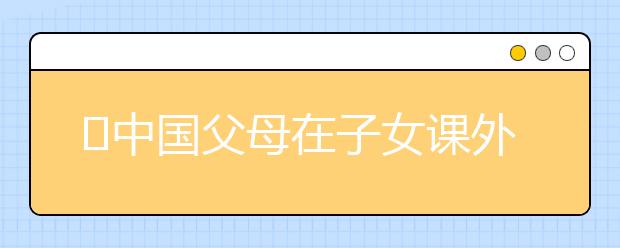 中国父母在子女课外辅导上花了多少钱
中国父母在子女课外辅导上花了多少钱
课外辅导是一种较为常见的课外学习活动,也是一种组织化的校外活动形式。特别是在中国的基础教育阶段,学校
2019年11月11日 22:19 全面禁止课外辅导机构,你支持吗?
全面禁止课外辅导机构,你支持吗?
有人说,校外培训机构是校内教育的完善和补充,然而也造成学生更多的学习压力和家长们的经济负担。社会上一
2019年11月11日 22:13 深度解读:课外辅导1对1,在线课,小班课,大班课,家长该如何选择?
深度解读:课外辅导1对1,在线课,小班课,大班课,家长该如何选择?
其实这是一个系统性问题,家长由于大部分只有一个孩子,经验非常有限,也不做教育方面的研究,所以很多时候
2019年11月11日 22:08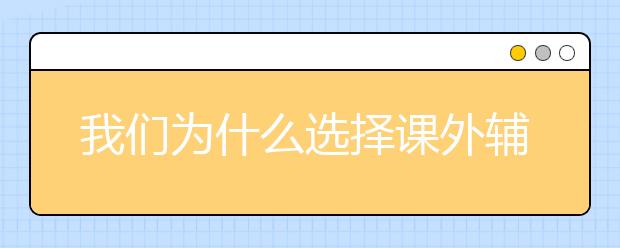 我们为什么选择课外辅导?
我们为什么选择课外辅导?
教育培训行业,在我的认知里是从2010年1月29日开始的。那时我刚刚进入新东方天津学校。面试、试讲、
2019年11月11日 22:00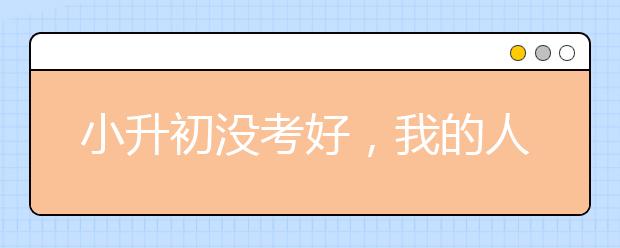 小升初没考好,我的人生好像完蛋了
小升初没考好,我的人生好像完蛋了
打开大学录取通知书,是高考考生们梦想成真的瞬间。同样的,在大洋彼岸的小岛国新加坡,每一年也有一群又一
2019年11月12日 13:14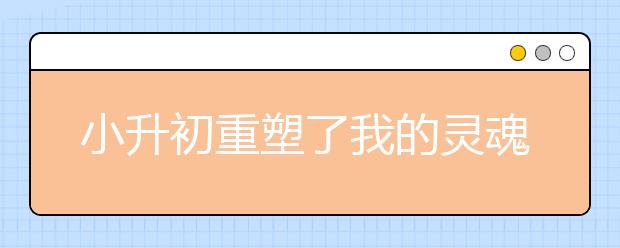 小升初重塑了我的灵魂,还有肉体
小升初重塑了我的灵魂,还有肉体
不经历一次小升初,我还以为九年义务教育没我啥事。小升初让我明白,家长需要经历的最严峻的义务可能来了,
2019年11月12日 13:05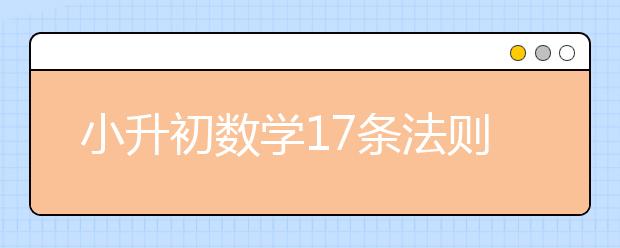 小升初数学17条法则,做题一定会用到!
小升初数学17条法则,做题一定会用到!
有很多家长们反应说,不知道为什么孩子对一些数学法则总是张冠李戴很是让人头疼,总是感觉是因为太调皮,所
2019年11月12日 13:02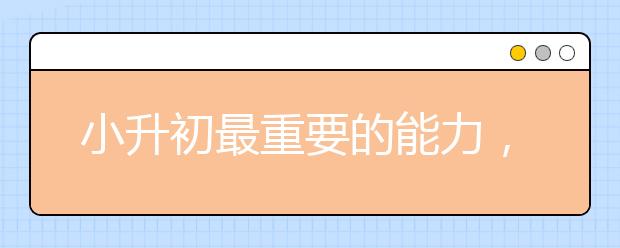 小升初最重要的能力,现在开始准备一点也不晚!
小升初最重要的能力,现在开始准备一点也不晚!
今日寄语"让孩子爱上阅读,必将成为你这一生最划算的教育投资"——毕淑敏前段时间看
2019年11月12日 12:59
教育部:推动有条件的地方优化学前教育班额和生师比
时间:2024年11月12日
教育部:严格幼儿园教师资质条件,把好教师入口关
时间:2024年11月12日
教育部:教职工存在师德师风问题、侵害幼儿权益要依法严肃追究责任
时间:2024年11月12日
教育部:教师存在师德师风问题,损害幼儿身心健康的,要依法追究责任
时间:2024年11月12日
教育部:2023年全国普惠性幼儿园覆盖率达90.8%
时间:2024年11月12日
2019英语六级考试复习用的什么资料 英语六级考试时间是几点到几点
时间:2024年06月08日
2021年3月16日以后从北京到辽宁朝阳还需要核酸检测吗 2021年3月16号离京用不用做核酸检测
时间:2024年06月08日
我昨天报好了志愿多久可以查看自己是否被录取呢 志愿填报后几天能知道被录取
时间:2024年06月08日
广东有那些高校录取线是在二批A线的 各省录取分数线一样吗
时间:2024年06月08日
内蒙古公务员考试网上报名及查询的具体步骤
时间:2024年06月08日